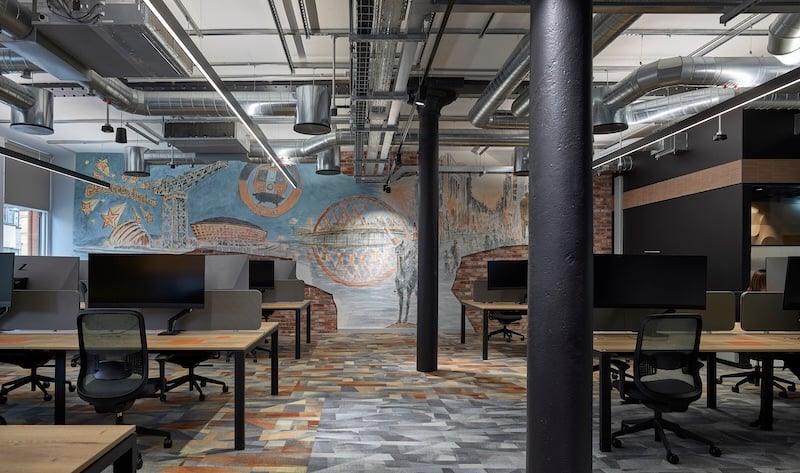In a digital-first world, it’s easy to overlook the power of print however, in commercial interior design, print is experiencing something of a renaissance. From patterned floor coverings to immersive wall graphics and soft furnishing fabrics, printed interior finishes are creating memorable experiences, connecting people and being used to express identity more than ever before.
Today, paradoxically, the juxtaposition of traditional print and modern digital design now has the capability to deliver powerful, statement interiors in a more customisable, flexible and economical way.
Here’s the top print design trends influencing today’s commercial interiors:
1. LARGE-SCALE WALL MURALS
Gone are the days of bland white walls. Today’s commercial spaces are embracing bold, full-wall graphics that turn entire rooms into storytelling canvases. These murals often feature:
- Abstract patterns or brand motifs
- Photographic cityscapes or landscapes
- Inspirational typography or company values
- Environmental statements
Usually printed onto vinyl or fabric, these wall coverings bring life to lobbies, meeting rooms, and collaborative areas, helping companies express their culture and creativity.

Lightbox carpet tiles at Wallace Whittle, Glasgow, Scotland
2. MODULAR AND REMOVABLE INTERIORS
As companies embrace flexible layouts and hybrid work models, interiors need be adaptable to changing needs. Modular printed floor coverings, moveable acoustic panels, peel-and-stick decals, and magnetic graphics are trending for their ease of use and minimal environmental impact.
When it comes to floor coverings, easy uplift and replacement is crucial. Milliken’s entire modular carpet portfolio is available with its TractionBack® friction coating which allows its carpet tiles to be installed without the use of adhesives. The ultimate in modular flexibility, this means they can be easily lifted, replaced and recycled without damage to the carpet tiles or the floor beneath. 
Northern Soul carpet tiles
3. BIOPHILIC-INSPIRED PRINT DESIGNS
Nature-inspired elements continue to trend, but not just in the form of living plants. Printed interior finishes that mimic natural organic textures, leaf patterns, wood grains and topographic maps are being integrated into floors, walls, partitions, ceilings, acoustic panels and furnishings.
These prints not only soften the aesthetic of a space but can also help to reduce anxiety and promote a sense of calm.
For the workplace, this is becoming increasingly important for employee well-being, productivity and retention.
Tektura Wallcoverings Heartleaf by Elli Popp
4. DESIGN CUSTOMISATION
Print design is relatively flexible and easy to customise to meet the specific needs of a customer or space.
As an example, Milliken’s Pattern Play carpet tile collection features a series of fun motifs, textures, transitions and an enormous palette of backdrop colours as standards. The playful theme behind the collection also means that customers have the opportunity to design their own motifs for their own interior design projects. The flexibility of Milliken’s Millitron® dye injection technology allows its design team to offer a unique custom design service for its carpet tiles.

Wayfinding, as another example, is no longer just about getting from point A to B. In modern office buildings, hospitals, hotels, and retail environments, wayfinding doubles as a branding opportunity.
 Coastline Transitions carpet tiles at Bluefloat & Renantis
Coastline Transitions carpet tiles at Bluefloat & Renantis
High-impact signage with custom typography, icons, and branded colour schemes is being printed on everything from floor decals to 3D wall panels. The result? Navigation that feels intuitive and on-brand.
5.INTERACTIVE AND AUGMENTED REALITY PRINT
Print design is merging with technology through QR codes, NFC tags, and even AR overlays and important. Printed elements like posters or wall decals now trigger digital content when scanned - perfect for employee onboarding, product education, or interactive art installations in client spaces.
perfect for employee onboarding, product education, or interactive art installations in client spaces.
This hybrid approach blends tactile and digital experiences, making print more engaging than ever.
6. SUSTAINABLE AND ECO-FRIENDLY PRINT MATERIALS
Sustainability is no longer a side show, it’s a priority. As design specifiers increasingly seek out sustainable, recyclable or biodegradable interior materials, manufacturers are responding with more innovative eco-friendly interior solutions.
 This year’s Clerkenwell Design Week was testament to this trend with most exhibitors showcasing some kind of sustainable product range. With the use of bold pattern and colour becoming increasingly apparent, among these in printed materials were sustainable wallcoverings, printed fabrics and floor coverings.
This year’s Clerkenwell Design Week was testament to this trend with most exhibitors showcasing some kind of sustainable product range. With the use of bold pattern and colour becoming increasingly apparent, among these in printed materials were sustainable wallcoverings, printed fabrics and floor coverings.
Sustainable print design can align with corporate ESG goals and can appeal to environmentally aware clients and employees.
Print design in commercial interiors goes beyond decoration and has become a flexible, sustainable and strategic element of a space. By integrating print thoughtfully, companies can improve the user experience, reinforce a brand’s identity and values while delivering an agile, sustainable material solution.
Pattern Play at Clerkenwell Design Week
As the rest of 2025 unfolds, expect even more innovation at the intersection of print, tech, and environmental design.







